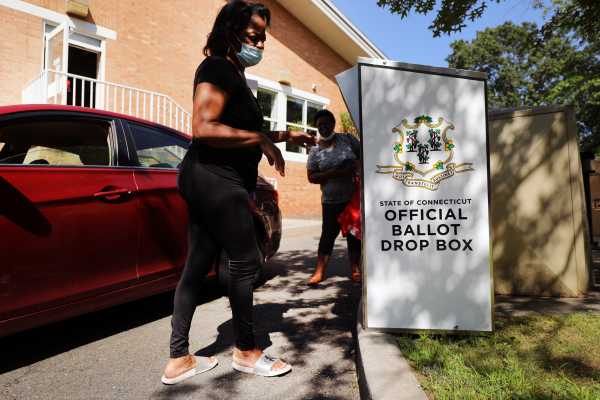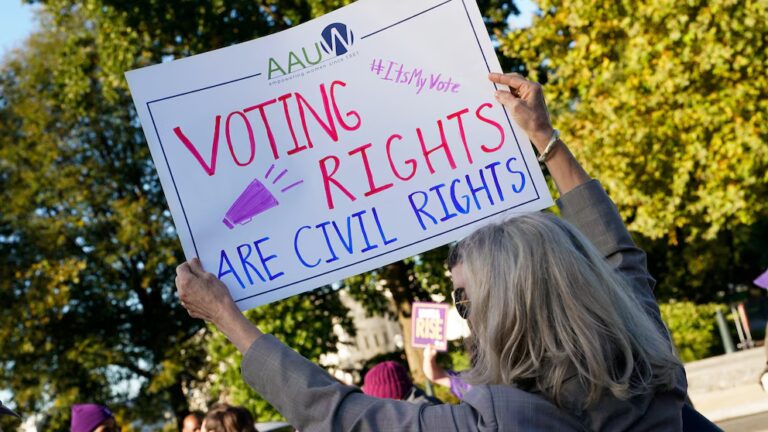
Throughout the 2020 presidential election, as President Donald Trump has repeatedly attacked voting by mail as prone to fraud (it’s not), he has also taken pains to distinguish between “voting by mail” and “absentee voting.”
Given that Trump himself is voting absentee in 2020, this hair-splitting on his part isn’t exactly shocking. But Trump’s specific claims — that absentee voting and “voting by mail” are somehow different, and that absentee voters “have to go through a whole process” different from that for mail voters — are worth addressing.
The short version is that there’s no firm distinction between absentee voting and voting by mail. There’s a colloquial distinction between the two, but not a legal one. And there’s no reason to think “voting by mail,” insofar as it informally refers to something different from “absentee voting,” is prone to fraud or other problems.
The difference between voting by mail and absentee voting
“Voting by mail” is typically used to refer to voting in the five states — Colorado, Hawaii, Oregon, Washington, and Utah — where all elections are conducted entirely by mail, and in the states of California, Nebraska, and North Dakota, where counties have the option to choose to conduct elections entirely by mail.
This year, California is going a step further due to Covid-19 and mailing ballots to every eligible voter, though some polling places will remain open. In Nebraska, where state law only allows counties with fewer than 10,000 people to mandate universal voting by mail, 11 counties will be doing so; this year, Douglas, Sarpy, and Lancaster counties, the three most populous in the state, are sending ballot request forms (but not actual ballots) to every voter.
A few states that are not traditionally vote-by-mail states are sending out ballots to all registered and/or eligible voters this year due to the unique circumstances of the pandemic. These states are New Jersey, Vermont, and Nevada, plus the District of Columbia.
“Absentee voting,” by contrast, tends to be used to refer to voting by mail in states or counties where the practice is not already universal. In most states where voting by mail isn’t universal, absentee voting is available for any reason — that is, voters do not need to provide an excuse for why they aren’t voting in person — at least in the 2020 election, due to the pandemic.
This no-excuse absentee voting is available in major swing states like Florida, Pennsylvania, Ohio, Michigan, and Wisconsin. In nine states — Iowa, Massachusetts, Ohio, Wisconsin, Maryland, Delaware, Illinois, Connecticut, and New Mexico — every registered voter is getting mailed an absentee ballot application, making them similar to the states mailing actual ballots to everyone, albeit with an extra step in the process.
But some states require excuses to vote absentee. The New York Times’s Juliette Love, Matt Stevens, and Lazaro Gamio looked up the state laws on this and note that Texas, New York, Indiana, South Carolina, Louisiana, and Mississippi all require certain excuses for voters to receive absentee ballots. The excuses the states will accept vary widely, per the National Council of State Legislatures. For instance, having a work shift during voting hours is a valid reason to request an absentee ballot in South Carolina and Louisiana, but not in Texas or New York. Some states — South Carolina, Texas, Mississippi, Louisiana, and Indiana — allow seniors above a certain age (usually 65) to request absentee ballots without needing another excuse.
Trump’s claims about absentee voting and vote-by-mail fraud are incorrect
In both absentee voting and “vote by mail,” insofar as they’re at all different, voter fraud is rare. One reason for this is the steps states take to make fraud all but impossible. For example, back in 2019, the Pacific Standard’s Spenser Mestel explained Oregon’s process for verifying ballots in its all-mail system:
It’s also important to note that, contrary to popular belief, absentee ballots don’t “only count” if an election is close. They are often the last ballots to be counted, so often blowout elections are “called” by news services before every absentee ballot is tallied up. But all votes are counted eventually. Ballots that might have eligibility problems (if, say, poll workers can’t confirm a voter is registered to vote) are sometimes classified as “provisional ballots,” which are counted after being investigated. But that’s a distinct issue from absentee ballots.
In short: Absentee and vote by mail are basically the same thing, both have low rates of fraud, and one of the two will be available to the vast majority of American voters on November 3, 2020.
Will you become our 20,000th supporter? When the economy took a downturn in the spring and we started asking readers for financial contributions, we weren’t sure how it would go. Today, we’re humbled to say that nearly 20,000 people have chipped in. The reason is both lovely and surprising: Readers told us that they contribute both because they value explanation and because they value that other people can access it, too. We have always believed that explanatory journalism is vital for a functioning democracy. That’s never been more important than today, during a public health crisis, racial justice protests, a recession, and a presidential election. But our distinctive explanatory journalism is expensive, and advertising alone won’t let us keep creating it at the quality and volume this moment requires. Your financial contribution will not constitute a donation, but it will help keep Vox free for all. Contribute today from as little as $3.
Sourse: vox.com






